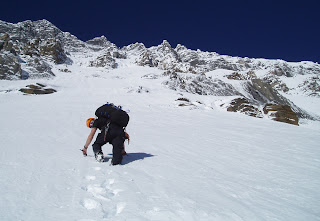"... and keep your heels down!"

A lot of factors contribute to competent ice climbing, such as technique, endurance and boldness. None of these comes easily, at least not to me. But something else that's key to efficient ice climbing is having one's systems dialed - and that's a bit easier to come by. Over the years I've developed my own set of habits that serve me well when venturing out into the cold. They are all rather self-evident, but maybe you will find one or two of them useful. In no particular order: For a full ice-climbing day I typically bring three pairs of gloves: thin ones for approaching, a favourite pair for climbing, and thick ones for belaying. That makes for two pairs on the climb. I clip the belay gloves to the back of my harness while climbing and change into them at belays, while the climbing gloves go deep inside my clothes to stay warm for the next pitch. Count on your approach gloves getting wet. If the approach is over an hour or so, I bring a spare pair of socks to change




